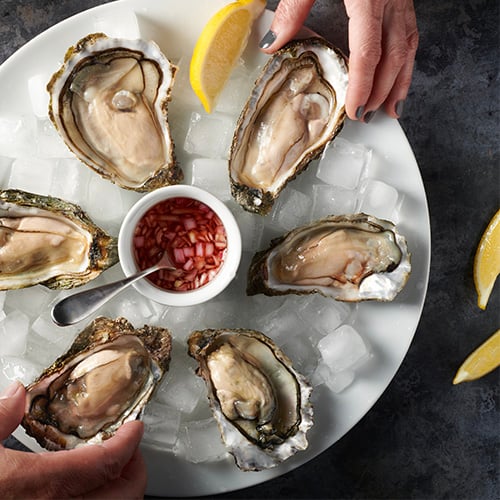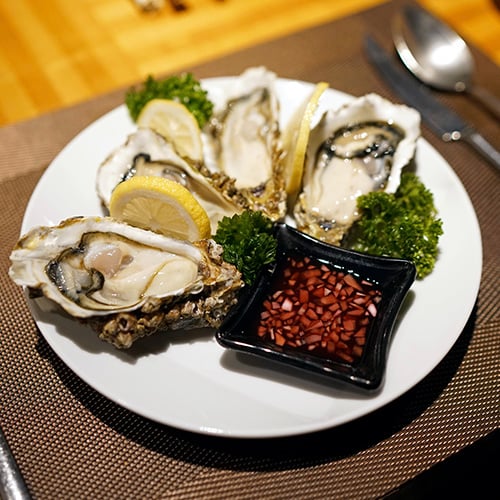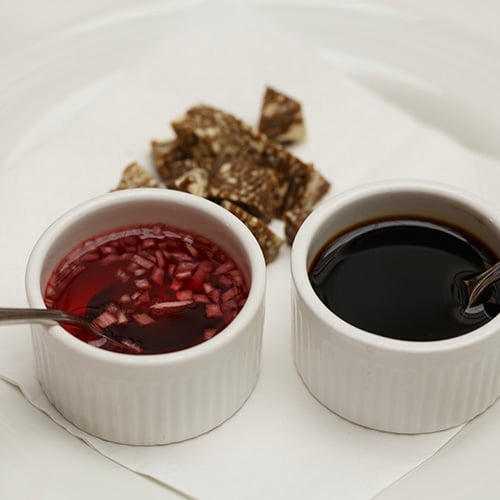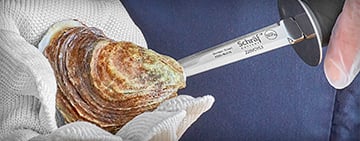You already know that food safety is extremely important, and that cross-contamination can lead to foodborne illness. But did you know there are certain foods that require special handling when it comes to time and temperature control? These foods are called TCS foods, and you might be surprised by some of the items on the list. We'll explain why these particular foods cause a problem and how you can handle them in the safest way possible.
Click below to learn about the different types of TCS foods:
Meat and Poultry
Milk and Dairy
Fish and Shellfish
Eggs
Tofu and Soy
Cooked Potatoes
Sprouts
Cut Leafy Greens
Cut Tomatoes and Melons
Cooked Rice, Beans, and Grains
Garlic and Oil Mixtures
TCS Food FAQs
TCS Foods Chart
What Is TCS Food?
TCS stands for time/temperature control for safety. Any foods that are designated as TCS require strict time and temperature control. But what does that mean exactly? Time and temperature control means you must monitor the temperature of the food and ensure it stays within a certain range for a designated length of time. When TCS foods are not monitored correctly for time and temperature, you run into problems with bacteria growth and foodborne illness. Time and temperature abuse occurs when foods enter the temperature danger zone.
List of TCS Foods
If you aren't familiar with TCS foods, you could be neglecting a big part of your food safety program. Check out our TCS foods list to learn more about each food and why it's at risk.
1. Meat and Poultry
It's ingrained in most of our minds that meat and poultry products can "go bad" if they aren't handled correctly. The reason that meat and poultry are considered TCS foods is because they provide a hospitable environment for bacteria and microorganisms. Moist, protein-rich, and acidic foods like meat and chicken already carry some bacteria, so it's important to stop growth in its tracks and kill any germs with proper storage and cooking.
Keep these tips in mind when handling meat and poultry in your kitchen:
Receiving Tips - Check the internal temperature of all animal proteins when they are delivered. They should be delivered at 40 degrees Fahrenheit or below. You should also inspect the shipment for signs of thawing and refreezing, which indicates the products may have warmed to an unsafe temperature. Reject any shipments of meat and poultry that read above 40 degrees Fahrenheit.
Prep Tips - Whenever you pull meat and poultry out of refrigeration, set a timer so you know how long it's been sitting at room temperature. The maximum amount of time it can be left out is 2 hours. After 2 hours it should either be cooked or put back into refrigerated storage.
Storage Tips - Cold storage for meat and poultry should be 40 degrees Fahrenheit and below. Hot holding for cooked meat or poultry should be above 135 degrees Fahrenheit.
Cooking Tips - Meat and poultry products need to be cooked to the following temperatures for at least 15 seconds: Poultry (165 degrees), ground or tenderized meats (155 degrees), steaks, chops, game meat, and roasts (145 degrees).
2. Milk and Dairy
The next group of TCS foods on our list is milk and dairy products. Just like other at-risk foods, dairy is rich in protein and makes an inviting environment for bacteria to thrive. The best way to prevent this is to make sure dairy products are always stored at the correct holding temperature. Apply “first in, first out” rules to organize your cold storage and use the oldest products first. Dispose of any dairy products that are past the “use by” date.
What Temperature Should Milk be Stored At?
Store all milk and dairy products at 40 degrees Fahrenheit or below. This includes dairy-based milk and any products that contain dairy milk, like cheese, sour cream, or butter.
How Long Does Milk Last in the Fridge?
Milk should only be kept in the fridge for 7 days. The exception is if the “use by” date has already passed, then the product should be disposed of right away.
Follow these tips for handling TCS milk and dairy products:
Receiving Tips - Dairy milk is safe to receive at 45 degrees Fahrenheit or below. All other dairy products must be delivered at 40 degrees Fahrenheit or below.
Storage Tips - If milk is received at temperatures between 41 and 45 degrees Fahrenheit, it must be cooled to 40 degrees within 4 hours. Store all dairy products at 40 degrees Fahrenheit or below.
Prep Tips - If you pull milk and dairy products out of refrigeration to use in a recipe, set a timer for 2 hours. At the end of 2 hours, the dairy products must either be cooked or put back into cold storage.
Cooking Tips - Any dish that contains a dairy product must be cooked to 165 degrees Fahrenheit for at least 15 seconds. Examples of cooked dishes that contain dairy are macaroni and cheese, lasagna, or fettuccine alfredo.
3. Fish and Shellfish
Fish and shellfish have a bad reputation for causing foodborne illnesses when improperly handled. Before you even receive a shipment of seafood, you should make sure you only source products from reputable suppliers. Safe seafood starts at the source, especially for sushi-grade fish and shellfish that are eaten raw. Look for suppliers with a strict food safety program and traceability practices.
Don’t be afraid to reject a seafood shipment that doesn’t look or smell right to you. Train your staff to inspect fish and shellfish carefully on arrival and to understand live shellfish tags.
Shellfish Tags
What is a shellfish tag? A shellfish tag should be attached to all shipments of live shellfish (crustaceans and mollusks). The label should provide the supplier’s name, the original harvest date, and harvest location. Other important info like the dealer’s certification number and the shipper’s certification number helps to identify and track shellfish shipments in the case of a contamination issue. You must keep all shellfish identification tags on file for 90 days.
Follow these tips for handling TCS fish and shellfish:
Receiving Tips - Any fish served raw or partially cooked must be received frozen (sashimi, sushi-grade, seared tuna). Shucked shellfish must be received at 45 degrees Fahrenheit or lower. Live shellfish must be tagged with a shellstock tag and received at 45 degrees Fahrenheit or lower.
Storage Tips - Live shellfish or shucked shellfish received between 41 and 45 degrees Fahrenheit must be cooled to 40 degrees or below in 4 hours. Store all fish and shellfish in cold storage.
Prep Tips - Never thaw frozen seafood on a counter. The best way to thaw seafood is to place it in the walk-in overnight. This ensures it never dips above 40 degrees.
Cooking Tips - Cook seafood to an internal temperature of 145 degrees Fahrenheit for at least 15 seconds.
4. Eggs
When you think of the safety concerns surrounding this TCS food, the bacteria Salmonella most likely comes to mind. Eggs can become contaminated with Salmonella on the inside and outside of the egg during the laying process, which makes proper handling very important. But as long as you follow time and temperature rules for storing, prepping, and cooking eggs, they are safe to serve and consume.
Pasteurized eggs have been heat-treated to destroy bacteria, making them a safer option for dishes that contain raw or undercooked eggs. If you serve high-risk populations in a hospital or other healthcare facility, you should stick with pasteurized egg products.
What Are Shell Eggs?
Shell eggs are fresh eggs in the shell. They are called shell eggs to differentiate them from other egg products.
What Are Pooled Eggs?
Pooling eggs is a common preparation method, especially for high-volume kitchens that serve breakfast. Several eggs are cracked into one mixing bowl and combined, making it easy for cooks to portion out eggs onto the griddle. The issue with pooling eggs occurs when the egg mixture sits out too long without being refrigerated and eggs are continuously added to the mixture. Pooled eggs should be cooked completely after mixing or stored at 40 degrees Fahrenheit.
Follow these tips for handling TCS shell eggs:
Receiving Tips - Shell eggs should be received at an air temperature of 45 degrees Fahrenheit or lower. Reject any cracked or dirty eggs.
Prep Tips - Wash hands after handling raw eggs, even if they are still in the shell. Wash and sanitize utensils, mixing bowls, or cutting boards that have come into contact with raw eggs.
Storage Tips - Store eggs and egg products at 40 degrees Fahrenheit or below.
Cooking Tips - Pooled eggs should be cooked immediately after mixing or stored in refrigeration. Cook shell eggs to 145 degree Fahrenheit for service or 155 degrees Fahrenheit for hot holding.
5. Tofu and Soy
You might be surprised to see tofu and soy listed as TCS foods. It’s a misconception that plant-based meat substitutes don’t require special handling. Tofu and other soy products contain protein and are moist environments, which puts them at risk for bacteria growth if they are time and temperature abused.
Does Tofu Go Bad?
Yes, tofu has the potential to spoil if it's handled improperly. Always check the expiration date on the package of unopened tofu. Discard any tofu or soy products that are past the “use by” date. If opened, tofu should be used within 3 or 4 days.
Follow these tips for handling TCS tofu and soy products:
Receiving Tips - Tofu and soy protein products should be received at 40 degrees Fahrenheit or below. Shelf-stable tofu in sterile packaging can be received at room temperature. Reject any soy or tofu packages that are leaking or unsealed.
Prep Tips - Just like other TCS foods, do not leave tofu and soy products unrefrigerated for more than two hours. At the end of two hours, the food must be cooked or put back in cold storage.
Storage Tips - Store tofu and soy proteins (cooked and uncooked) at 40 degrees Fahrenheit or below. Shelf-stable tofu can be stored at room temperature in the original package.
Cooking Tips - Cook all tofu and soy products to an internal temperature of at least 135 degrees Fahrenheit.
6. Cooked Potatoes
Cooked potatoes are another TCS food that poses a risk for bacteria growth when they are handled incorrectly. You might be wondering how potatoes cause an issue if they are already cooked. Prepared TCS foods that are cooked can easily enter the temperature danger zone if they aren’t stored or held properly. This is a common issue with baked potatoes and potato salads.
Learn more about the proper way to cool cooked foods in our cooling foods guide.
Follow these tips for handling TCS cooked potatoes:
Receiving Tips - Cooked potato dishes like pre-made potato salads should be received at 40 degrees Fahrenheit or below.
Prep Tips - Cooked potato dishes that need to be cooled down for storage should follow the two-stage cooling process. Cool potatoes to between 135 and 70 degrees Fahrenheit in two hours or less, then cool to between 70 and 41 degrees in 4 hours or less.
Storage Tips - Do not put warm potatoes in cold storage. Make sure to follow the two-step cooling process before putting potatoes in cold storage at 40 degrees Fahrenheit or below.
Cooking Tips - Cook or reheat any dishes containing potatoes to at least 165 degrees Fahrenheit.
7. Sprouts or Sprouted Seeds
Sprouts and sprouted seeds are on the list of TCS foods because they have the potential to be hazardous when consumed. The ideal growing environment for sprouts is moist and humid, the same conditions that encourage bacteria growth. This, combined with the fact that sprouts are often eaten raw, makes them a potential cause of foodborne illness.
Sprouts that have been contaminated at the source may show no signs that bacteria is present, which makes them extremely risky, especially for populations with weakened immune systems. Avoid serving raw sprouts to children, older adults, and pregnant women. The only way to ensure there is no bacteria present on sprouts is to cook them. If you simply must serve raw sprouts, include a disclaimer on your menu warning that consuming raw sprouts may result in an increased risk of foodborne illness.
Follow these tips for handling TCS raw sprouts:
Receiving Tips - Raw sprouts should be received at 40 degrees Fahrenheit or below. Reject any shipments of sprouts that look dirty or slimy.
Prep Tips - Wash hands after handling raw sprouts. Wash and sanitize utensils and cutting boards that have come into contact with raw sprouts.
Storage Tips - Store raw sprouts in cold storage at 40 degrees Fahrenheit or below.
Cooking Tips - Some types of sprouts can be cooked, which is much safer than consuming them raw. Cook sprouts to at least 135 degrees Fahrenheit to kill potential bacteria.
8. Leafy Greens
Once leafy greens are cut, they become a TCS food. The part of the leaf that is cut or torn becomes an entryway for bacteria or microbes to contaminate the lettuce. This applies to all types of greens, including romaine, spring mix, spinach, and kale. All cut leafy greens should be stored at 40 degrees Fahrenheit or below to prevent the growth of pathogens. Heads of lettuce that haven’t been cut can be stored at room temperature.
You’ll also want to make sure you wash heads of lettuce and other greens to remove dirt and grit. Check out our guide to washing lettuce so that it stays fresh and crisp.
Follow these tips for handling TCS cut leafy greens:
Receiving Tips - Pre-cut greens should be received at 40 degrees Fahrenheit or below. To check the temperature of bagged lettuce, place the thermometer between two bags or fold a bag firmly around the probe.
Prep Tips - After leafy greens have been cut, they shouldn’t be left out of cold storage for more than 2 hours.
Storage Tips - Store all cut leafy greens at 40 degrees Fahrenheit or below.
Cooking Tips - For any cut greens that are cooked, like collards, chard, or kale, make sure they reach a temperature of at least 135 degrees Fahrenheit.
9. Cut Tomatoes and Melons
Though it may be surprising, cut tomatoes and melons are considered TCS foods. The intact skin and rind of these foods prevent bacteria growth, but once the flesh is exposed by being sliced or cut, it becomes vulnerable. Salmonella, in particular, grows quickly on cut tomatoes and cantaloupe. To prevent any issues, store cut tomatoes and melons at 40 degrees Fahrenheit or below.
The greatest risk occurs when cut tomatoes and melons are left out of cold storage and allowed to enter the temperature danger zone. Picnics, barbecues, and outdoor catered events spell trouble for TCS foods that aren’t held with cold storage. Keep melons and tomatoes chilled and perform temperature checks every two hours.
Follow these tips for handling TCS cut tomatoes and melons:
Receiving Tips - Uncut tomatoes and melons are fine to receive at room temperature. Any pre-cut tomatoes and melons should be received at 40 degrees Fahrenheit or below.
Prep Tips - Wash melons and tomatoes thoroughly before cutting. Once cut, don’t let the product sit out of cold storage longer than 2 hours. Adding vinegar, lemon juice, or lime juice to cut tomatoes decreases the risk of bacteria growth.
Storage Tips - Store all cut melons and tomatoes at 40 degrees Fahrenheit or below.
Cooking Tips - Cooked dishes that contain fresh-cut tomatoes should be heated to at least 165 degrees Fahrenheit.
10. Cooked Rice, Beans, Grains, and Vegetables
Dried rice, beans, pasta, and grains aren’t considered TCS foods until they are cooked. The dried form of these foods can be stored at room temperature, but once they are reconstituted and heated, they become susceptible to bacteria growth. The same rule applies to fresh vegetables that are cooked. Any dish that contains cooked rice, beans, vegetables, or pasta must be treated as a TCS food and kept out of the temperature danger zone.
Follow these tips for handling TCS cooked rice, beans, pasta, grains, and vegetables:
Receiving Tips - Pre-made dishes that contain cooked rice, beans, grains, vegetables, or pasta must be received at 40 degrees Fahrenheit or below.
Prep Tips - When working with cooked rice, beans, grains, vegetables, or pasta as an ingredient in a recipe, treat the dish just like any other TCS food.
Storage Tips - Do not put warm rice, beans, grains, vegetables, or pasta in cold storage. Make sure to follow the two-step cooling process before putting these foods in cold storage at 40 degrees Fahrenheit or below.
Cooking Tips - Cook rice, beans, grains, vegetables, or pasta to at least 135 degrees Fahrenheit. Cook or reheat any dishes containing these cooked foods as an ingredient to at least 165 degrees Fahrenheit.
11. Untreated Garlic and Oil Mixtures
Raw garlic is considered resistant to some bacteria, so how did it end up on the TCS foods list? When you take peeled, minced, or roasted garlic cloves and add them to oil, the mixture has the potential to create a breeding ground for the bacteria that causes botulism. If you make your own garlic oil mixtures, don’t leave them out at room temperature or you are risking a case of foodborne illness.
Commercially prepared garlic in oil is preserved using strict guidelines that prevent the growth of any bacteria, so you have no worries there. The greatest risk comes with preparing your own garlic-infused oils. Store these in cold storage at 40 degrees Fahrenheit or below.
Follow these tips for handling TCS garlic and oil mixtures:
Receiving Tips - Pre-made and unopened jarred or canned garlic-in-oil can be received at room temperature. The exception to this is any homemade garlic-in-oil mixtures that are not treated with preservatives. These must be received at 40 degrees Fahrenheit or below.
Prep Tips - Be extremely cautious if making your own garlic-in-oil mixtures. It’s best to use freshly prepared garlic oil immediately.
Storage Tips - Store all garlic-in-oil mixtures in cold storage at 40 degrees Fahrenheit or below. Discard homemade mixtures after three days.
Cooking Tips - There is no standard temperature for cooking garlic-in-oil mixtures, but some sources cite 250 degrees Fahrenheit or above.
TCS Foods FAQs
We answer some common questions about TCS foods below:
What Does TCS Stand For in Food Safety?
TCS stands for time and temperature control for safety.
Is Bread a TCS Food?
Bread is not considered a TCS food because it doesn't provide a moist environment where bacteria can thrive. This doesn't mean that bread won't go bad under certain conditions, but bread is more susceptible to mold growth than the types of bacteria that cause foodborne illness.
Which Foods Do Not Need Temperature Control?
Besides bread, there are many foods that don't require temperature control. Dried beans and grains, dry goods like flour and sugar, unopened canned foods, uncut fruits, and packaged foods can be stored at room temperature.
What Is the TCS Danger Zone Temperature Range?
The danger zone for TCS foods is between 41 and 135 degrees Fahrenheit.
Is It 40 or 41 Degrees?
You'll notice that many resources across the web will either state 40 degrees or 41 degrees Fahrenheit as the safe maximum temperature for cold foods. In our resources, we recommend that foods be kept at 40 degrees or below because that is the common pre-set temp range for most commercial refrigeration.
Train your staff to handle all TCS foods with care and follow time and temperature requirements. Keeps these foods out of the danger zone, cool them properly for storage, and heat them to the correct temperature for serving.
TCS Foods Cheat Sheet
Print out this handy TCS foods chart and hangit up in your commercial kitchen as a helpful reminder to your staff:











